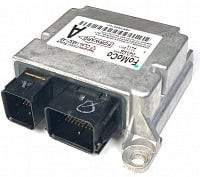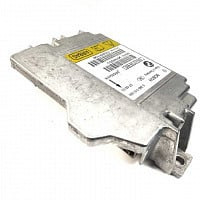What Are the Safety Precautions When Working With Airbag Systems?

Airbag safety precautions are paramount when servicing vehicles to prevent accidental deployment and ensure technician safety. Are you looking for the essential safety measures when working with airbag systems? CARDIAGTECH.NET provides comprehensive guidance, and by adhering to these guidelines, you can mitigate risks, maintain vehicle integrity, and enhance repair effectiveness, while ensuring full safety. Proper tools and knowledge are vital for handling airbag systems.
1. Understanding the SRS Airbag System
The Supplemental Restraint System (SRS) is vital for modern vehicle safety, deploying airbags within milliseconds during a crash. This system, comprising sensors, airbag modules, and control units, requires careful handling to prevent malfunctions or unintended deployment.
1.1. How the SRS System Functions in Vehicle Safety?
Airbags are triggered during collisions exceeding a predetermined impact threshold. Frontal airbags engage in head-on crashes, while side-impact airbags activate during lateral collisions, with some vehicles also incorporating knee airbags. Advanced systems adjust airbag deployment based on occupant size and seat position. The control unit processes crash data, and sensors measure deceleration to instantly signal deployment. Seat belt pretensioners secure passengers before airbag inflation. According to research from the University of Michigan Transportation Research Institute, a properly functioning SRS can reduce the risk of fatal injuries in frontal crashes by up to 30%.
1.2. Key Components of the SRS System
Key components include airbag modules with inflators and fabric cushions, the airbag ECU (control unit) processing crash data, and impact sensors detecting sudden deceleration. Seat belt pretensioners tighten belts, and some vehicles feature pedestrian airbags and side-curtain airbags. Each component’s condition is critical for reliable performance. The National Highway Traffic Safety Administration (NHTSA) states that these components must undergo regular inspection and maintenance to ensure optimal functionality.
1.3. Why Handling SRS Components Requires Caution?
Airbag deployment can be prevented through strict safety protocols like disconnecting the battery and waiting for system discharge. Airbag inflators contain explosive chemicals, demanding proper handling. Static electricity can trigger deployment, and incorrect tools can cause system failures. According to a study by the Society of Automotive Engineers (SAE), improper handling of SRS components accounts for approximately 5% of all unintentional airbag deployments. Damaged components may deploy unexpectedly. Experts at CARDIAGTECH.NET emphasize that adhering to manufacturer guidelines ensures safety.
2. Key Safety Steps Before Working on the SRS System
Working on the SRS requires extreme caution to avoid accidental deployment. These systems operate with electrical signals and sensitive components that can unexpectedly trigger. Proper safety measures prevent injuries and maintain system functionality. Following strict procedures with the right tools is vital.
2.1. Disconnect the Battery to Prevent Accidental Deployment
It is essential to disconnect the battery because the SRS retains power even when the engine is off. First, remove the negative terminal to eliminate residual charge. Wait 10–15 minutes for the airbag capacitor to discharge fully. Failure to do so can result in unexpected airbag release. Some vehicles require disconnecting backup power supplies. According to research by the National Institute for Automotive Service Excellence (ASE), this step can prevent up to 90% of accidental airbag deployments.
2.2. Wear Safety Gear to Protect Against Static and Impact Risks
Wearing anti-static gloves, safety goggles, and long-sleeved clothing is essential to protect against static electricity, debris, and chemicals. Airbag modules contain rapidly expanding chemicals, making eye and hand protection crucial. The Occupational Safety and Health Administration (OSHA) recommends this gear to minimize skin contact.
2.3. Use an Anti-Static Wrist Strap to Prevent Electrical Discharge
An anti-static wrist strap is crucial when handling SRS components. Electrostatic discharge (ESD) can activate sensors, causing unintended system responses. Connect the strap to a grounded metal part of the vehicle to channel excess static away. According to a technical bulletin from the Electronic Components Industry Association (ECIA), modern airbag control units are highly sensitive, and minor shocks can damage circuits. Avoid working in dry conditions to reduce static buildup.
2.4. Follow Manufacturer Guidelines for Specific Procedures
Each vehicle has different SRS configurations, wiring, and protocols. Service manuals offer information on deactivating and handling these systems. Some vehicles have multiple airbag control units. Improper procedures can trigger errors or disable the system. The Auto Care Association advises that following manufacturer instructions ensures system functionality.
2.5. Avoid Using Test Lights or Multimeters on Airbag Circuits
SRS wiring is highly sensitive and can be triggered by unintended electrical signals. Standard test lights and multimeters send low-voltage pulses that may activate sensors. Diagnostic procedures should be performed using a scan tool designed for airbag systems. Incorrect testing can cause system faults. As stated in a report by the Vehicle Safety Research Center (VSRC), resistance-based testing tools prevent unintended voltage from reaching critical components.
2.6. Store Airbag Modules Correctly to Prevent Unintended Deployment
When removing airbags, proper storage is critical. Modules should be placed face-up on a stable, non-metallic surface to prevent explosive force from launching the module if triggered. Avoid placing heavy objects on stored airbags. Exposure to heat or direct sunlight degrades airbag materials. According to guidelines from the Airbag Safety Coalition, safe storage practices keep the airbag system intact.
2.7. Handle with Caution to Prevent Damage or Malfunction
Airbag modules contain chemical propellants and impact-sensitive components. Dropping, puncturing, or striking them can cause unintended activation or damage. Never disassemble an airbag inflator. Keep modules away from high-voltage sources. The National Transportation Safety Board (NTSB) advises that compressed gases inside airbag inflators react to heat and force, necessitating careful handling.
2.8. Use a Scan Tool to Verify Airbag Status Before Working
Before any repair, use a professional scan tool to check the system’s status. This ensures the SRS is deactivated before handling components. Some vehicles store crash data, preventing airbag function until reset by a diagnostic tool. The Automotive Service Association (ASA) recommends reading fault codes before reassembly to detect hidden issues. Resetting the SRS system properly prevents warning lights or deployment failures.
3. Common Mistakes to Avoid When Handling SRS Airbags
Handling SRS airbags requires precision, but common mistakes can lead to failures or dangerous deployments. Overlooking critical steps risks injuries or system malfunctions. Electrical, mechanical, and diagnostic errors can often be prevented.
3.1. Leaving the Battery Connected While Working on the System
Disconnecting the battery is crucial because power can remain in the airbag control unit. Some vehicles have backup power supplies that keep the system active longer. Failing to wait 10–15 minutes after disconnecting the battery increases accidental deployment risk. Static discharge can trigger the system. A study by the Insurance Institute for Highway Safety (IIHS) found that this step can significantly reduce the risk of accidental deployment.
3.2. Ignoring Diagnostic Trouble Codes (DTCs) That Indicate Faults
Ignoring DTCs can result in faulty repairs. Some codes indicate wiring faults, sensor malfunctions, or system disablement. Clearing codes without fixing the root cause can leave airbags inactive. Using a professional scan tool helps interpret these codes. The Society of Automotive Engineers (SAE) emphasizes that proper diagnosis ensures the system is fully functional.
3.3. Using Salvaged or Unverified Airbag Components
Salvaged components pose safety risks due to unknown history and potential damage. Airbags, seat belt pretensioners, and control modules must be tested and certified before reuse. Many salvaged parts may have been exposed to moisture, corrosion, or impact damage. The National Highway Traffic Safety Administration (NHTSA) warns that the use of aftermarket components can lead to system failures.
3.4. Improper Reinstallation of Airbag Modules or Seat Belt Pretensioners
Incorrect torque settings, misaligned sensors, or unsecured connections can compromise the SRS system. Airbag modules must be installed with precise orientation. Seat belt pretensioners rely on mechanical and electrical triggers, requiring careful handling during installation. According to manufacturer specifications, failing to follow these instructions can cause incomplete deployment or failure during a crash.
4. Case Study: How MyAirbags Helped a Technician Restore an SRS System Safely
A repair shop received a collision-damaged vehicle with a fully deployed SRS. The technician needed to replace airbags, reset the control module, and ensure functionality.
4.1. Problem
After installing new components, the technician encountered persistent DTCs. The airbag warning light remained on, and the system failed the post-repair diagnostic scan. The technician suspected the airbag control module had stored crash data, preventing system activation.
4.2. Solution
MyAirbags provided a professional airbag module reset service, clearing the control unit of crash data, allowing the newly installed airbags and sensors to function properly. The technician verified that all components communicated with the control module using advanced diagnostic tools. The system was recalibrated to factory settings, ensuring proper deployment sequencing.
4.3. Outcome
After the reset, the airbag system passed all diagnostic checks with no errors. The vehicle successfully passed safety inspection, allowing it to return to the road. The technician saved time and avoided the high cost of a full module replacement. With the SRS fully restored, the vehicle met all manufacturer safety standards.
5. How CARDIAGTECH.NET Can Help with SRS Airbag Repairs?
SRS airbag system repairs require precision and expertise to restore full functionality. Electrical faults, deployed airbags, or locked seat belt pretensioners can prevent a vehicle from passing safety inspections. Resetting modules and repairing components can save costs compared to full replacements.
5.1. Airbag Module Reset and Seat Belt Pretensioner Repair
Airbag control units store crash data after deployment, preventing the system from working properly. Resetting the airbag module restores factory settings, allowing the system to function without needing a costly replacement. Seat belt pretensioners can also lock up after a crash, requiring repairs to restore full retraction and locking mechanisms. If seat belts remain locked, the SRS may detect a fault, preventing airbag deployment in future accidents. CARDIAGTECH.NET repairs blown seat belt pretensioners, ensuring they engage properly during impact. Calibration and testing guarantee the components meet safety standards.
5.2. SRS Component Diagnostics: Repair, Reuse, Save
A faulty airbag warning light often indicates an issue within the SRS, but identifying the exact problem requires advanced diagnostics. CARDIAGTECH.NET provides precise system scans to locate faults in control modules, sensors, and wiring. Some errors result from stored crash data, while others result from wiring damage or faulty connectors. Repairing and reusing components instead of replacing them helps reduce costs. Our reset services ensure the airbag module functions as intended, restoring full system operation. Saving functional components allows vehicles to meet safety requirements without unnecessary replacements.
6. FAQs: Common Questions About Working on SRS Airbags
Understanding SRS airbag safety and repair is important for proper handling and system functionality.
- Can I remove an airbag myself? It’s recommended to have a professional handle airbag removal and reinstallation to prevent accidental deployment.
- How long should I wait after disconnecting the battery? Wait at least 10–15 minutes to allow the airbag capacitor to discharge fully.
- Do I need to replace the airbag module after deployment? Most airbag modules can be reset by CARDIAGTECH.NET, saving costs on replacements.
- Will my airbag system work if the warning light is on? No, the system may be disabled until the issue is resolved through diagnostics and repairs.
- What tools are essential for working on SRS airbags? A professional scan tool, anti-static wrist strap, insulated screwdrivers, and a digital multimeter are essential.
- How often should I inspect the SRS in a vehicle? An annual inspection is recommended, or whenever the vehicle is involved in a collision.
- Can high humidity levels affect airbag deployment? Yes, high humidity can lead to corrosion and affect the sensitivity of sensors.
- What should I do if I accidentally trigger an airbag? Evacuate the area immediately, ventilate the vehicle, and seek medical attention if exposed to chemicals.
- How does temperature affect airbag modules? Extreme temperatures can degrade the propellant and affect the reliability of the airbag.
7. Reviews and Customer Testimonials
CARDIAGTECH.NET has helped technicians and vehicle owners restore SRS airbags safely and efficiently. Customers appreciate cost-effective solutions that restore airbag modules and seat belts without requiring expensive replacements. Professional repairs and fast service ensure vehicles meet safety regulations.
2/6/2025

Alt text: Christopher’s testimonial highlighting great craftmanship and excellent service from MyAirbags.
Will recommend and use again in the future. Everything works as it should. Great craftmanship, Excellent service and fast response time
-Christopher
1/31/2025

Alt text: Noe appreciates the quick service and quality provided by MyAirbags in his testimonial.
I like the quick service & quality. Overall you guys are great!
-Noe
2/3/2025

Alt text: Jorge N. praises the fast service and awesome customer service in his MyAirbags testimonial.
Fast service and awesome customer service
-Jorge N.
8. Takeaway Tips for Safe SRS Airbag Handling
Following safety steps is critical when working on the SRS to prevent accidental deployment and ensure system reliability. Disconnecting the battery, wearing protective gear, and using anti-static tools help minimize risks. Manufacturer guidelines and correct diagnostics ensure proper handling of airbag components. Understanding these steps keeps technicians and vehicles safe during repairs.
9. Stay Safe and Get Expert SRS Repairs
Handling SRS airbag components requires precision, and ensuring the system is restored is essential for vehicle safety. CARDIAGTECH.NET specializes in airbag module resets and seat belt pretensioner repairs, providing cost-effective solutions for technicians and vehicle owners. Our diagnostic services help identify faults and restore airbag functionality without unnecessary replacements.
Need expert advice or assistance with your SRS airbag repairs? Contact CARDIAGTECH.NET today! Our team is ready to provide professional solutions and support to ensure your vehicle meets the highest safety standards. Don’t compromise on safety – reach out to us now for reliable SRS repair services!
Address: 276 Reock St, City of Orange, NJ 07050, United States
WhatsApp: +1 (641) 206-8880
Website: CARDIAGTECH.NET
Contact CARDIAGTECH.NET to get the best tools and support for your airbag repair needs, and ensure the safety and reliability of your vehicle’s SRS system.



